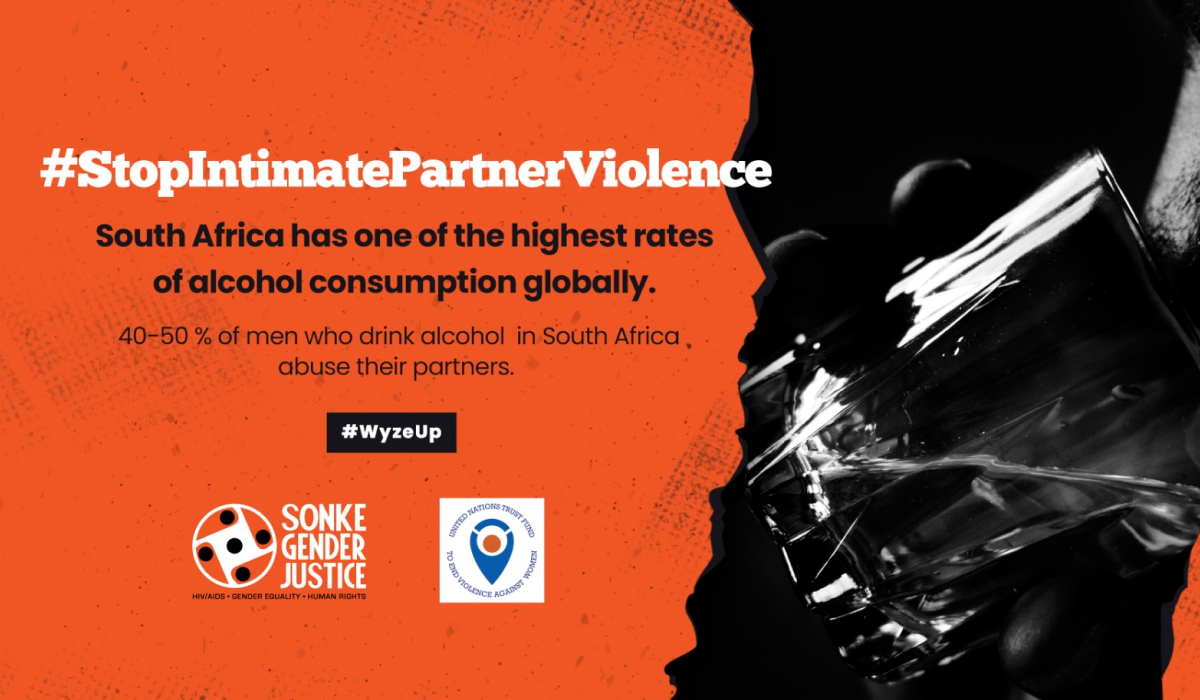Namuma Mulindi, Policy Development and Advocacy Specialist
Thenjiwe Hlatshwayo has endured abuse from her alcoholic husband for the 23 three years of their marriage that resulted in her having a disabled child when he pushed her while pregnant. Hers is one of many stories that demonstrate how alcohol can fuel intimate partner violence and therefore requires that the government adopts a holistic approach to legislate alcohol.
Alcohol abuse and gender based violence and femicide (GBVF) are co-occurring public-health threats to sub-Saharan Africa. Where alcohol is consumed, men are three times more likely to commit intimate partner violence and it increases the risk of women experiencing gender-based violence by six times. In South Africa and Swaziland, alcohol and other substance use are identified as drivers of Gender Based Violence (GBV) and femicide, according to the Medical Research Council (MRC) Between 64-69% of men drink in South Africa and 40-50% of those who drink perpetrate IPV, according to the MRC.
The problem is huge and growing yet the legislation to regulate particularly the advertising, licensing, distribution, sales and consumption of alcohol is lacking. It should be noted that the country’s Liquor Policy of 2016 has already made recommendations in respect of all of these factors – what is needed now is to develop legislation which gives effect to that policy.
How alcohol is consumed is a consequence of how it is advertised and distributed. A 2013 study revealed the link between alcohol advertising and its impact on consumption. Alcohol advertising often normalises and glamorises alcohol and therefore fosters beliefs that encourage use and sometimes misuse.
Alcohol advertising is subject to self-regulation by the industry in line with self- generated guidelines and remains so because a bill to ban alcohol advertising and sponsorship— the Control of Marketing of Alcoholic Beverages Bill— has been stalled since 2013 due to pressure from the alcohol, advertising industry, media and sporting industries, which have an economic interest in preventing it from being passed. And therefore denying South Africans the opportunity to democratically participate in the determination of alcohol regulation for the country.
Liquor regulation in South Africa is also not homogenous. The 1996 Constitution gives provincial governments responsibility for the licensing of micro manufacturers and retailers who sell alcohol to the public. This mandate is vested in provincial liquor boards/authorities. The Constitution also gives municipalities responsibility for the control of undertakings that sell liquor to the public.
As a result, liquor policy, legislation and regulation is fragmented, varying from province to province and, where local government exercises its mandate, from municipality to municipality. Furthermore, there is little real alignment between national, provincial and local policies and practices. Additionally, there is little effort by the government to ensure that the public is fully informed of their rights with respect to the regulation and control of alcohol sales and consumption.
For example, the Eastern Cape Liquor Board (ECLB) passed the Eastern Cape Liquor Authority Act of 2018. This piece of legislation has not yet been proclaimed or shared so alcohol is still managed through the province’s 2003 Liquor Act. But even if the 2018 Act is proclaimed, it does not expressly provide for a mechanism for formal complaints or an appeals process that enables members of the community to object to the awarding of liquor licences. Furthermore, the involvement of the community in the liquor licensing process has not been facilitated. The legislation cannot be found on the ECLB website and there is nothing on the ECLB’s website to help community members understand their rights in the liquor licensing process, to inform them of where licences have been applied for or to guide them on how to object to a liquor licence application. In Gauteng, the Liquor Board doesn’t even have a website and there is no easy way to find out who serves on it and what their responsibilities and functions are. This means that communities do not have any platforms for a recourse in cases where they are susceptible to the impact of alcohol misuse.
But why is the effective regulation of alcohol important in the fight against gender based violence?
Many interpersonal violence cases involved physical attacks by men on women. Research has shown that around 60% of these GBVF cases are alcohol-related. Men use alcohol as a scapegoat to cover physical and psychological violence on their women and children (Mzibuko & Ikechukwu, 2014) Anyone anywhere can experience gender based violence but the areas that are often hardest hit tend to be those that are also most affected by poverty, particularly the townships. The impact is devastating on the economic and mental wellbeing of survivors and their families with most at higher risk of engaging in risky behaviours that increase their risk of being abused. For example, Thenjiwe also became an alcoholic to escape the stress induced by the abuse from her alcoholic husband. The consequences also extend from the individual and families to the economy as well. KPMG estimates that the economic impact of the violence against women and girl children was 28.4 billion and 42.4 billion in 2012/2013 alone.
Alcohol abuse has also contributed to the rise of rape incidents and affects an individual’s cognitive functions, reducing their ability to have self-control and to negotiate non-violent resolutions to conflicts. Heavy drinking is also often a cause of stress and conflict within family members. Witnessing this alcohol induced violence can result in childhood trauma and quite often children raised in these homes turn to alcohol and substance abuse to cope, (Beyene etal (2019).
The link between alcohol consumption and GBVF needs to be addressed. It is not enough for the government to adopt a ‘national strategy’ to address GBVF crimes. A more conscious effort must be made to address the drivers of GBVF starting with effective national alcohol regulation. This means that the national Liquor Amendment Bill of 2016, which gives effect to the national Liquor Policy approved by Cabinet in 2016, must be strengthened to ensure that it effectively reduces alcohol-related harm and is passed as soon as possible.
It also means that the government must ensure that the public is educated about their rights so they can effectively participate in helping to reduce the harmful use of alcohol. Municipalities also need to inform the public on how to establish if licences have been applied for, on their right to object to such licences, or on how to exercise that right. Communities need to be empowered to have a say in when, where and how alcohol is sold and consumed in their neighbourhoods, so that they can play their part in helping to reduce alcohol-related harm, particularly gender-based violence and femicide.
This will also help to create a society in which the health, safety and well-being of women like Thenjiwe Hlatshwayo is a priority and a human right.
You can read more of Thenjiwe’s story and other blogs in the series here
Watch the video on the correlation between alcohol misuse and intimate partner violence here


